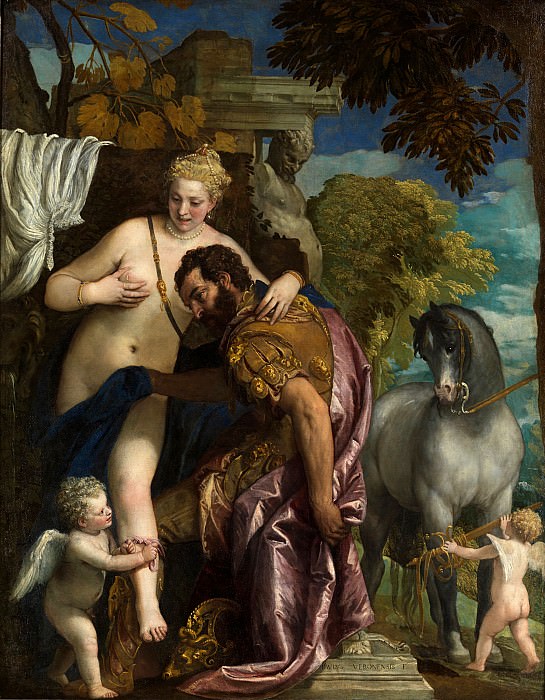Mars and Venus United by Love Veronese (Paolo Cagliari) (1528-1588)
Veronese – Mars and Venus United by Love
Edit attribution
Download full size: 1595×2051 px (0,9 Mb)
Painter: Veronese (Paolo Cagliari)
Paolo Veronese was a prominent representative of the Venetian school of painting. There were quite a few famous artists there. Paolo Veronese stood out brightly among them. He created many picturesque canvases on mythological themes. Bright, expressive, extraordinary in beauty canvas "Mars and Venus" is a masterpiece, recognized throughout the world. The painting is also distinguished by the fact that it has many titles.
Description of Paolo Veronese’s painting Mars and Venus
Paolo Veronese was a prominent representative of the Venetian school of painting. There were quite a few famous artists there. Paolo Veronese stood out brightly among them. He created many picturesque canvases on mythological themes. Bright, expressive, extraordinary in beauty canvas "Mars and Venus" is a masterpiece, recognized throughout the world.
The painting is also distinguished by the fact that it has many titles. These are "Mars and Venus, Bound by Love," "Mars, seducing Venus," "Venus and Mars, bound by Cupid" and many others. The artist painted the picture in the seventies of the 16th century. Now it is exhibited in the New York Metropolitan Museum of Art.
There is speculation that this painting was commissioned by Veronese by Rudolph II, the emperor, for the day on which he was to be crowned. The painting reveals a mythological subject in which the main characters are the gods of the ancient world. Mars and Venus are in the center of the painting, with Cupid nestled at her feet.
Mars, virile, militant, ventures into battle, here, next to Venus, beautiful, extremely feminine, erotically attractive, calm, even subdued, thoughtful. And Cupid seals their love union by tying a silk ribbon around their legs. All the characters in the painting, the horse, Cupid, Satyr and the main characters are a majestic hymn to Love.
The horse here is a symbol of passion, Cupid is the deity of Love in ancient Greek mythology, Satyr, who symbolizes lust, is held tightly by the stone so that Satyr does not interfere with the pure feeling of love of Mars and Venus.
Everything in this picture breathes with sublime love. Cupid with a sword stands in front of the horse (base passion), keeping it out of Love, Satyr (lust) keeps out the stone, which seems to have absorbed the servant Bacchus into itself. However, the erotic sensuality is not only felt in the naked Venus. Her beautiful femininity is emphasized by the thread of pearls in her blond hair, the pearl necklace around her neck and the gold bracelets on both hands.
The viewer literally touches, feels in person the silky smoothness of the horse, the weight of the cloak hanging from Mars’ shoulder, and feels the warmth of white marble. From the affectionate gesture of Venus (her hand rests calmly on Mars’ shoulder) comes tenderness.
Paolo Veronese, that Master, here too, painted the spirit of luxurious, affluent and affluent Venice, a city of celebration with its famous carnivals and 16th-century piers.
Кому понравилось
Пожалуйста, подождите
На эту операцию может потребоваться несколько секунд.
Информация появится в новом окне,
если открытие новых окон не запрещено в настройках вашего браузера.
You need to login
Для работы с коллекциями – пожалуйста, войдите в аккаунт (open in new window).









![Veronese (Paolo Cagliari) - The Rape of Europa [After]](http://cdn.gallerix.asia/j/V/1948194332/3430.webp)










You cannot comment Why?
To the right, a powerful steed stands tethered, its musculature rendered with considerable detail and realism. The animal’s presence reinforces the martial aspect of the male figure, yet it also appears restrained, mirroring perhaps the mans own internal conflict or subjugation to love. Two diminutive winged figures flank the central grouping; they are depicted as playful observers, one holding a bow and arrow, suggesting the potential for disruption or intervention in this union.
The background is layered with architectural elements – a classical ruin partially obscured by foliage – and a vista of rolling hills under a cloudy sky. The use of atmospheric perspective creates depth within the scene, drawing the viewers eye towards the distant horizon. A sense of enclosure is established through the dense vegetation that frames the figures, contributing to an overall feeling of seclusion and intimacy.
Subtleties in color contribute significantly to the painting’s meaning. The woman’s skin tones are rendered with a luminous quality, contrasting with the darker hues of the mans armor and the surrounding foliage. This contrast emphasizes her centrality within the composition. The gold accents on her jewelry and the cushions she rests upon further highlight her status and desirability.
The painting explores themes of love, war, and reconciliation. The union between these figures – one associated with martial prowess and the other with beauty and affection – suggests a potential for harmony between opposing forces. However, the man’s posture and averted gaze introduce an element of uncertainty; his willingness to relinquish power or control remains ambiguous. The presence of the winged figures hints at the capricious nature of love and its capacity to disrupt even the most seemingly stable relationships. Ultimately, the work invites contemplation on the complexities of human desire and the challenges inherent in bridging disparate realms of experience.